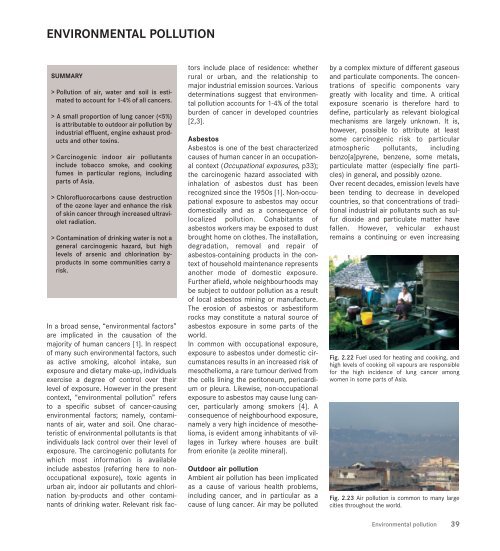world cancer report - iarc
world cancer report - iarc
world cancer report - iarc
Create successful ePaper yourself
Turn your PDF publications into a flip-book with our unique Google optimized e-Paper software.
ENVIRONMENTAL POLLUTION<br />
SUMMARY<br />
> Pollution of air, water and soil is estimated<br />
to account for 1-4% of all <strong>cancer</strong>s.<br />
> A small proportion of lung <strong>cancer</strong> ( Carcinogenic indoor air pollutants<br />
include tobacco smoke, and cooking<br />
fumes in particular regions, including<br />
parts of Asia.<br />
> Chlorofluorocarbons cause destruction<br />
of the ozone layer and enhance the risk<br />
of skin <strong>cancer</strong> through increased ultraviolet<br />
radiation.<br />
> Contamination of drinking water is not a<br />
general carcinogenic hazard, but high<br />
levels of arsenic and chlorination byproducts<br />
in some communities carry a<br />
risk.<br />
In a broad sense, “environmental factors”<br />
are implicated in the causation of the<br />
majority of human <strong>cancer</strong>s [1]. In respect<br />
of many such environmental factors, such<br />
as active smoking, alcohol intake, sun<br />
exposure and dietary make-up, individuals<br />
exercise a degree of control over their<br />
level of exposure. However in the present<br />
context, “environmental pollution” refers<br />
to a specific subset of <strong>cancer</strong>-causing<br />
environmental factors; namely, contaminants<br />
of air, water and soil. One characteristic<br />
of environmental pollutants is that<br />
individuals lack control over their level of<br />
exposure. The carcinogenic pollutants for<br />
which most information is available<br />
include asbestos (referring here to nonoccupational<br />
exposure), toxic agents in<br />
urban air, indoor air pollutants and chlorination<br />
by-products and other contaminants<br />
of drinking water. Relevant risk fac-<br />
tors include place of residence: whether<br />
rural or urban, and the relationship to<br />
major industrial emission sources. Various<br />
determinations suggest that environmental<br />
pollution accounts for 1-4% of the total<br />
burden of <strong>cancer</strong> in developed countries<br />
[2,3].<br />
Asbestos<br />
Asbestos is one of the best characterized<br />
causes of human <strong>cancer</strong> in an occupational<br />
context (Occupational exposures, p33);<br />
the carcinogenic hazard associated with<br />
inhalation of asbestos dust has been<br />
recognized since the 1950s [1]. Non-occupational<br />
exposure to asbestos may occur<br />
domestically and as a consequence of<br />
localized pollution. Cohabitants of<br />
asbestos workers may be exposed to dust<br />
brought home on clothes. The installation,<br />
degradation, removal and repair of<br />
asbestos-containing products in the context<br />
of household maintenance represents<br />
another mode of domestic exposure.<br />
Further afield, whole neighbourhoods may<br />
be subject to outdoor pollution as a result<br />
of local asbestos mining or manufacture.<br />
The erosion of asbestos or asbestiform<br />
rocks may constitute a natural source of<br />
asbestos exposure in some parts of the<br />
<strong>world</strong>.<br />
In common with occupational exposure,<br />
exposure to asbestos under domestic circumstances<br />
results in an increased risk of<br />
mesothelioma, a rare tumour derived from<br />
the cells lining the peritoneum, pericardium<br />
or pleura. Likewise, non-occupational<br />
exposure to asbestos may cause lung <strong>cancer</strong>,<br />
particularly among smokers [4]. A<br />
consequence of neighbourhood exposure,<br />
namely a very high incidence of mesothelioma,<br />
is evident among inhabitants of villages<br />
in Turkey where houses are built<br />
from erionite (a zeolite mineral).<br />
Outdoor air pollution<br />
Ambient air pollution has been implicated<br />
as a cause of various health problems,<br />
including <strong>cancer</strong>, and in particular as a<br />
cause of lung <strong>cancer</strong>. Air may be polluted<br />
by a complex mixture of different gaseous<br />
and particulate components. The concentrations<br />
of specific components vary<br />
greatly with locality and time. A critical<br />
exposure scenario is therefore hard to<br />
define, particularly as relevant biological<br />
mechanisms are largely unknown. It is,<br />
however, possible to attribute at least<br />
some carcinogenic risk to particular<br />
atmospheric pollutants, including<br />
benzo[a]pyrene, benzene, some metals,<br />
particulate matter (especially fine particles)<br />
in general, and possibly ozone.<br />
Over recent decades, emission levels have<br />
been tending to decrease in developed<br />
countries, so that concentrations of traditional<br />
industrial air pollutants such as sulfur<br />
dioxide and particulate matter have<br />
fallen. However, vehicular exhaust<br />
remains a continuing or even increasing<br />
Fig. 2.22 Fuel used for heating and cooking, and<br />
high levels of cooking oil vapours are responsible<br />
for the high incidence of lung <strong>cancer</strong> among<br />
women in some parts of Asia.<br />
Fig. 2.23 Air pollution is common to many large<br />
cities throughout the <strong>world</strong>.<br />
Environmental pollution 39

















